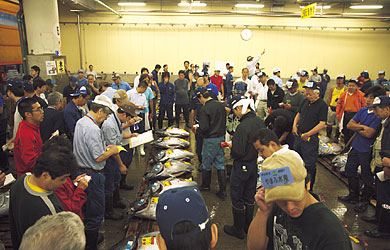Japan Travelogue Tsukiji Market
The world’s biggest fish market, Tsukiji, is just a 15-minute walk from Ginza, a fashionable district in the heart of Tokyo. The Japanese have a love of seafood that is rarely matched, so Tsukiji plays an important role in Japan’s diet. The buildings sit on about 230,000 square meters of land—a huge urban lot—with wholesale auction floors for buyers of tuna and many, many other types of seafood, about 800 outlets run by sales brokers, and the type of specialty shops and restaurants you would expect to find next to a major fish market.
Every day, about 480 types of seafood—around 2,000 tons of it—are delivered here from all over Japan, and from around the globe as well. In one day, about 1.8 billion yen changes hands on the wholesale floor—no other food market in the world surpasses this sum.
About 200 tons of the fish is tuna, 3,000 tuna fish sold every day, and more than 5,000 when it gets really busy. That is a lot of tuna, but it gets snapped up by buyers in almost no time at all, showing just how busy this market is.
We invite you on a virtual tour, first to the tuna auction hall. Come before dawn, a little after 4 a.m. when the action is already picking up. The hall is about the size of a sports arena. The floors, walls, even the ceiling, are all concrete. It is cold inside like an immense refrigerator, to protect the tuna from deteriorating. Hundreds of frozen tuna, all frosty white, lie side by side on the floor. A layer of white mist hangs over them, coming from their frigid bodies. Through the layer of mist walk the rubber boots of men who hover and dart about. Come closer and you will see how they check the condition of certain tuna, using hooks to pull at the flesh where the tails were cut off, and flashlights to peer inside the flesh. These men are tuna sales brokers, taking time before the auction to check the fat content and figure out how recently the tuna were caught and frozen. Their aim? To figure out which tuna they want, and decide how much they are willing to pay.
Suddenly a bell clangs with an awful racket. And just as suddenly, people call out from all over the place, voices pitched in a strange way you have never heard before. “Hai, san-ban, san-ban!” (Over here, number 3, number 3!) comes from one man, “Yon-ban, yon-ban, yon-ban!” from another (yon means “four”). The clock says 5:30 a.m., and the tuna auction is in full swing.
The auctioneer shouts out numbers identifying individual tuna, and all of the brokers bidding on that fish move their fingers at the same time, indicating their bid. For newcomers like us it is impossible to know how much they are bidding, or even who has the winning bid. Each sale takes only six seconds or so, and all the while the auctioneer keeps up his chanting. This auction is for buyers able to play hardball by the second.





